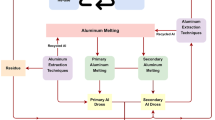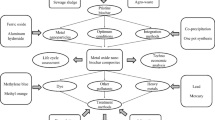Abstract
An innovative and sustainable approach to deal with the environmental pollution is the use of self-cleaning cement based materials for the construction of masonry structures and buildings in the urban cities. The photocatalytic activity, imparted to the self-cleaning cement by incorporating photocatalytic materials, has a significant role to combat the menace of urban air pollution. The most widely used photocatalytic material for formulation of self-cleaning cement is the nanosized-TiO2 (n-TiO2). However, the utilization of n-TiO2 for the synthesis of self-cleaning cement has numerous disadvantages such as higher cost, nano-toxicity and agglomeration in the cementitious matrix, which are the huge barriers in the commercialization of self-cleaning cement. In order to avoid the aforementioned drawbacks, the present work involves a study on the use of surface-fluorinated microsized-TiO2 (m-TiO2) and calcined dolomite for the formulation of self-cleaning cement. The surface-fluorinated m-TiO2, calcined dolomite, and the formulated self-cleaning cement were characterized using DRS, XRD, FE-SEM, EDS, XPS, SEM, BET analysis, and EDXRF. The self-cleaning property of the as-prepared self-cleaning cement was evaluated using the methylene blue (MB) test. The depolluting ability of the formulated self-cleaning cement was assessed through continuous NOx removal test. The antimicrobial activity of the self-cleaning cement was appraised using the method of zone of inhibition. The as-prepared self-cleaning cement obtained by uniform mixing of 87% clinker, 10% calcined dolomite, and 3% surface-fluorinated m-TiO2 showed a remarkable self-cleaning property by providing 53.9% degradation of the coated MB dye; noteworthy depolluting ability by removing 5.5% of NOx from the air; and significant antimicrobial property by inactivating the B. subtiltis bacteria.












Similar content being viewed by others
References
Akono A-T (2020) Effect of nano-TiO2 on C-S–H phase distribution within Portland cement paste. J Mater Sci 55:11106–11119
AmbikakumariSanalkumar KU, Yang EH (2021) Self-cleaning performance of nano-TiO2 modified metakaolin-based geopolymers. Cem Concr Compos 115:103847
Bianchi CL, Gatto S, Nucci S, Cerrato G, Capucci V (2013) Self-cleaning measurements on tiles manufactured with microsized photoactive TiO2. Adv Mater Res 2:65
Bolashikov ZD, Melikov AK (2009) Methods for air cleaning and protection of building occupants from airborne pathogens. Build Environ 44:1378–1385
Chen Y, Chen F, Zhang J (2009) Effect of surface fluorination on the photocatalytic and photo-induced hydrophilic properties of porous TiO2 films. Appl Surf Sci 255:6290–6296
Dass A, Srivastava S, Chaudhary G (2021) Air pollution: a review and analysis using fuzzy techniques in Indian scenario. Environ Technol Innov 22:101441
Dozzi MV, Selli E (2013) Effects of phase composition and surface area on the photocatalytic paths on fluorinated titania. Catal Today 206:26–31
Folli A, Pade C, Hansen TB, De Marco T, MacPhee DE (2012) TiO2 photocatalysis in cementitious systems: Insights into self-cleaning and depollution chemistry. Cem Concr Res 42:539–548
Fujishima A, Zhang X, Tryk DA (2008) TiO2 photocatalysis and related surface phenomena. Surf Sci Rep 63:515–582. https://doi.org/10.1016/J.SURFREP.2008.10.001
Galai H, Pijolat M, Nahdi K, Trabelsi-Ayadi M (2007) Mechanism of growth of MgO and CaCO3 during a dolomite partial decomposition. Solid State Ionics 178:1039–1047
Ganguly P, Byrne C, Breen A, Pillai SC (2018) Antimicrobial activity of photocatalysts: fundamentals, mechanisms, kinetics and recent advances. Appl Catal B Environ 225:51–75
Ganji N, Allahverdi A, Naeimpoor F, Mahinroosta M (2016) Photocatalytic effect of nano-TiO2 loaded cement on dye decolorization and Escherichia coli inactivation under UV irradiation. Res Chem Intermed 42:5395–5412
Ipe BI, Lehnig M, Niemeyer CM (2005) On the generation of free radical species from quantum dots. Small 1:706–709. https://doi.org/10.1002/smll.200500105
Joost U, Juganson K, Visnapuu M, Mortimer M, Kahru A, Nõmmiste E, JoostUrmeliKisand V, Ivask A (2015) Photocatalytic antibacterial activity of nano-TiO2 (anatase)-based thin films: effects on Escherichia coli cells and fatty acids. J Photochem Photobiol B Biol 142:178–185
Karapati S, Giannakopoulou T, Todorova N, Boukos N, Antiohos S, Papageorgiou D, Chaniotakis E, Dimotikali D, Trapalis C (2014) TiO2 functionalization for efficient NOxremoval in photoactive cement. Appl Surf Sci 319:29–36
King MD, McFarland AR (2012) Use of an Andersen bioaerosol sampler to simultaneously provide culturable particle and culturable organism size distributions. Aerosol Sci Technol 46:852–861
Lin C-Y, Li C-S (2002) Control effectiveness of ultraviolet germicidal irradiation on bioaerosols. Aerosol Sci Technol 36:474–478
Liu D (2021) Value evaluation system of ecological environment damage compensation caused by air pollution. Environ Technol Innov 22:101473. https://doi.org/10.1016/J.ETI.2021.101473
Meng C, Dong P, Tian H, Cheng T, Li J, Liu Y, Yang X, Xie M, Chen X, Xi X (2020) Photocatalytic concrete paving block reinforced by TiO2 nanotubes for NO removal. J Mater Sci 55:14280–14291
Metcalf AR, Narayan S, Dutcher CS (2018) A review of microfluidic concepts and applications for atmospheric aerosol science. Aerosol Sci Technol 52:310–329
Mills A, Elouali S (2015) The nitric oxide ISO photocatalytic reactor system: measurement of NOx removal activity and capacity. J Photochem Photobiol A Chem 305:29–36. https://doi.org/10.1016/j.jphotochem.2015.03.002
Minero C, Mariella G, Maurino V, Vione D, Pelizzetti E (2000) Photocatalytic transformation of organic compounds in the presence of inorganic ions. 2. Competitive reactions of phenol and alcohols on a titanium dioxide− fluoride system. Langmuir 16:8964–8972
Mrowetz M, Selli E (2005) Enhanced photocatalytic formation of hydroxyl radicals on fluorinated TiO2. Phys Chem Chem Phys 7:1100–1102
Munishwar SR, Pawar PP, Janbandhu SY, Gedam RS (2020) Highly stable CdS quantum dots embedded in glasses and its application for inhibition of bacterial colonies. Opt Mater 99:109590
Özyıldız F, Güden M, Uzel A, Karaboz I, Akil O, Bulut H (2010) Antimicrobial activity of TiO2-coated orthodontic ceramic brackets against Streptococcus mutans and Candida albicans. Biotechnol Bioprocess Eng 15:680–685
Pacheco-Torgal F, Jalali S (2011) Nanotechnology: advantages and drawbacks in the field of construction and building materials. Constr Build Mater 25:582–590
Padmanabhan NT, John H (2020) Titanium dioxide based self-cleaning smart surfaces: a short review. J Environ Chem Eng 8:104211
Park H, Choi W (2004) Effects of TiO2 surface fluorination on photocatalytic reactions and photoelectrochemical behaviors. J Phys Chem B 108:4086–4093
Paumo HK, Dalhatou S, Katata-Seru LM, Kamdem BP, Tijani JO, Vishwanathan V, Kane A, Bahadur I (2021) TiO2 assisted photocatalysts for degradation of emerging organic pollutants in water and wastewater. J Mol Liq 331:115458
Ratan JK, Saini A, Verma P (2018) Microsized-titanium dioxide based self-cleaning cement: Incorporation of calcined dolomite for enhancement of photocatalytic activity. Mater Res Express 5:115509
Saini A, Arora I, Ratan JK (2020) Photo-induced hydrophilicity of microsized-TiO2 based self-cleaning cement. Mater Lett 260:126888
Shayegan Z, Lee C-S, Haghighat F (2018) TiO2 photocatalyst for removal of volatile organic compounds in gas phase–a review. Chem Eng J 334:2408–2439
Vélez-Peña E, Pérez-Obando J, Pais-Ospina D, Marín-Silva DA, Pinotti A, Cánneva A, Donadelli JA, Damonte L, Pizzio LR, Osorio-Vargas P, Rengifo-Herrera JA (2020) Self-cleaning and antimicrobial photo-induced properties under indoor lighting irradiation of chitosan films containing Melon/TiO2 composites. Appl Surf Sci 508:144895
Victor FS, Kugarajah V, Bangaru M, Ranjan S, Dharmalingam S (2021) Electrospun nanofibers of polyvinylidene fluoride incorporated with titanium nanotubes for purifying air with bacterial contamination. Environ Sci Pollut Res 28:37520–37533
Wiszniewska M, Walusiak-Skorupa J, Gutarowska B, Krakowiak A, Palczynski C (2009) Is the risk of allergic hypersensitivity to fungi increased by indoor exposure to moulds? Int J Occup Med Environ Health 22:343
Yamamoto O (2001) Influence of particle size on the antibacterial activity of zinc oxide. Int J Inorg Mater 3:643–646
Yang J, Wang G, Wang D, Liu C, Zhang Z (2017) A self-cleaning coating material of TiO2 porous microspheres/cement composite with high-efficient photocatalytic depollution performance. Mater Lett 200:1–5
Acknowledgements
The authors acknowledge the support of all kind obtained from Dr BR Ambedkar National Institute of Technology, Jalandhar-144011 (India). The authors are also thankful to M/s JK White Cement Works, Gotan (Rajasthan), India for providing thrust to initiate this research work.
Author information
Authors and Affiliations
Corresponding author
Ethics declarations
Conflict of interest
The authors declare that they have no conflict of interest.
Additional information
Publisher's Note
Springer Nature remains neutral with regard to jurisdictional claims in published maps and institutional affiliations.
Rights and permissions
About this article
Cite this article
Saini, A., Ratan, J.K. Formulation and evaluation of surface-fluorinated microsized-TiO2 based self-cleaning cement: characterization, self-cleaning, depollution and antimicrobial study. Chem. Pap. 76, 3201–3214 (2022). https://doi.org/10.1007/s11696-022-02093-4
Received:
Accepted:
Published:
Issue Date:
DOI: https://doi.org/10.1007/s11696-022-02093-4




